Category: Wireless & Apps
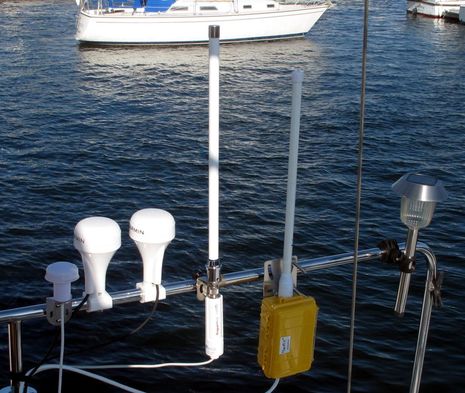
Perhaps the main thing I learned while testing the Rogue Wave and the WireAP this summer is that I love having a private WiFi hotspot on Gizmo. The Rogue is Ethernet cabled to Land & Sea’s refurbished Netgear router and both are wired to a 12v fuse block, while of course the WireAP simply has a single 12v feed because both its high power WiFi client and access point are in that yellow waterproof case. So in either case I can step aboard, flip one switch and if the last shore hotspot used is still available then everything that can be online via Wifi — Datalux nav computer, Mac Mini, iPad, iPhone, Android Incredible, or even the Vizio TV — is online whenever it’s powered up…
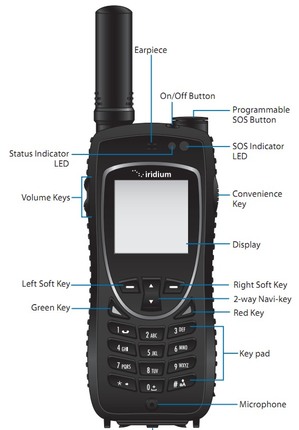
“Iridium Force” — announced today with much fanfare — seems to be an entire “vision for the future of personal mobile satellite communications”, a bunch of new hard- and software products, and what may be a heck of a business strategy. You can read the press release or sign onto a whole Iridium site full of videos and more, but just the hardware tells a lot of the story. The new Iridium 9575 Extreme handset seen above is not just a highly ruggedized version of Iridium’s most recent 9555 sat phone; it includes an internal GPS, a dedicated SOS button, and it seems capable of doing most everything that devices based on Iridium’s 9602 SBD modem can do, like, say, the DeLorme inReach and the YellowBrick3 that are both due to ship soon…
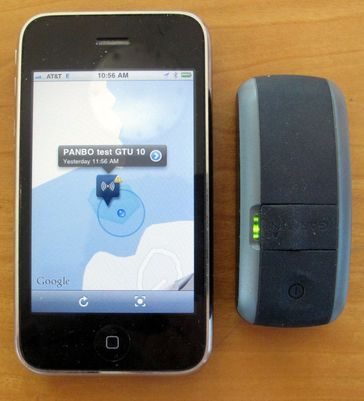
I’m pretty impressed with the Garmin GTU10 I’ve been testing this summer. Inside that little IPx7 waterproof case is a sensitive GPS, a GSM cell modem, and a fairly able lithium ion battery. For $200 you get the hardware, a cute case (meant primarily for hanging on a dog collar), and a one year standard data subscription which normally costs $50. The subscription doesn’t get you much in terms of remote tracking — just the last ten points, whose spacing will vary with settings — but you do get unlimited notifications about when the GTU 10 enters and/or leaves up to 10 geofence areas that you can define at mygarmin.com, or with the free Android and iOS Garmin Tracker apps. And aren’t geofences the key to knowing that your boat or tender are where they’re supposed to be, especially when anchored?…
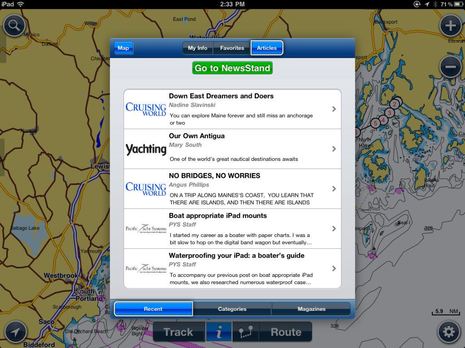
Months ago I heard that Navionics was planning to add boating magazine content to its mobile charting apps, but I didn’t know until the new 2.0 version came out that “my” Bonnier Marine Group was a lead participant! The implementation is pretty slick too. As long as your iPad or iPhone is online you can browse the “NewsStand” for cruising pieces relevant to your location or for articles listed by various subject categories or even ranked by reviews from fellow Navionics Mobile users. And you can download and read them two ways…

The UK company Yellowbrick has made a name for itself primarily by supplying offshore racing fleets with self-contained tracking devices based on Iridium’s original 9601 short burst data modem. But the new Yellowbrick 3 hardware announced this week is build around the smaller, less expensive, and more able 9602 modem and Yellowbrick intends to sell it as a standalone marine safety, tracking, and communications product as well as use it for fleet rentals. Yes, the Yellowbrick 3 is similar to the DeLorme inReach announced earlier this summer, but it’s got more features and flexibility, and it costs more…
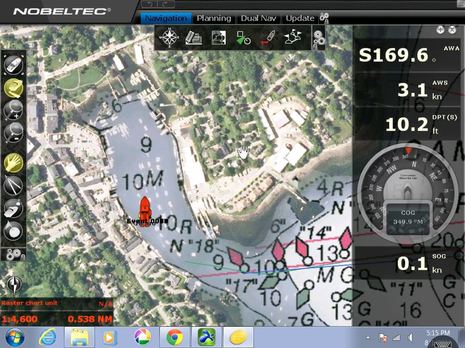
Yes, that’s Nobeltec Time Zero Trident running on Gizmo’s Mac Mini with NMEA 2000 data coming in via Actisense NGT-1 — as seen in an earlier entry on ChartTable21 — but, wow, the screen shot was taken on my iPad. And I had complete control of Trident from the pad without any noticeable delay in commands or zoom/pan screen refreshes, even with the intense graphic data seen in those nicely blended MapMedia hi res photo maps. If you’re interested in extending an onboard PC navigation system over WiFi to an Apple (or Android) pad you may recall that in October the possibilities weren’t thrilling, but that was before Splashtop Remote Desktop came along…
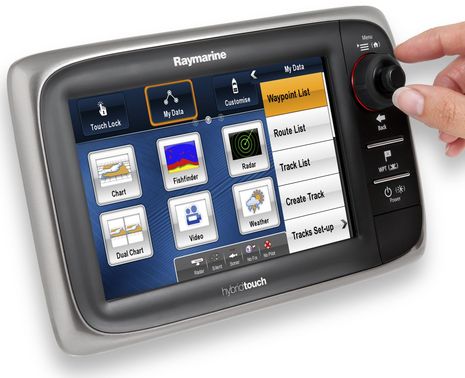
The Raymarine e7 being announced today may be the most important launch of the year, because it’s not only a hot new 7-inch MFD design but it also marks a complete refresh of Ray’s multifunction display software. While it uses the “hybridtouch” mix of touchscreen and keypad controls introduced in the E Wide Series — though with notably fewer and bigger buttons — I understand that the underlying code began at zero serveral years ago. And I see a lot of fresh interface ideas in the many product photos you’ll find after the break. But while the e7 will network with up to five other e7s and all sorts of existing Raymarine sensors and black boxes, it apparently will not network with existing Ray MFDs, which may be the downside of a complete software rewrite. But then again, it surely can make some interesting new connections…
It hasn’t gotten much press yet, but Sabre Yachts recently introduced something called LaunchPad, which is a collection of boat specific apps and services that purchasers of certain Sabre models will receive on an...
A few weeks ago I tweeted about how I’d had a nice dinner meeting with Raymarine and that they had all sorts of interesting product news that I couldn’t write about yet. But, dang,...
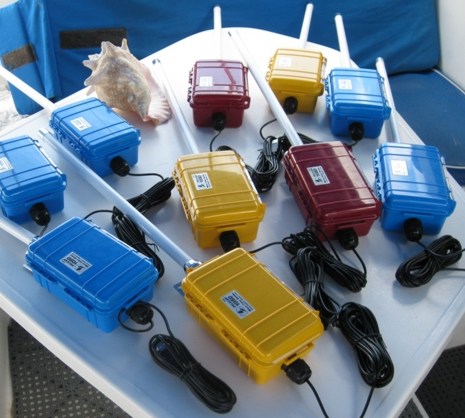
The original Wirie — seen above being assembled on a cruising boat in the Caribbean — is a 1,000 mW USB WiFi transceiver which seems smartly set up for marine use and has many fans. But I’ve been one of those boaters who prefers an Ethernet-based alternative because it can be installed beyond USB cable length limitations, plus it can go right to a router and thus easily serve the Internet to multiple devices. (A particularly good Ethernet-based, high-power WiFi radio is the Ubiquity Bullet, which is available in many marine packages, as we discussed at length last Fall.) However, the new WirieAP model adds a local boat WiFi access point to that waterproof plastic case, which means that the install only requires a 12 volt feed to let every WiFi-enabled device on board share a well-amplified shore-side Internet connection…

















